#sr17
Photo

Corps de torche tig flexible SR9/SR17/SR26 #torche_mig_bernard #torche_tig_mig_binzel #parkertorches #starweld #starweld_maroc #gant_de_soudage #torche_de_soudage_tig_mig_plasma_parker #poste_à_souder_tig_mma_mig #awsoudage #soudage_soudeur_maroc #chalumeau_soudeur_coupeur #torche_plasma_hypertherm #Mano_detendeur_argon_yildiz_gaz #tablier_soudeur #materiel_de_soudure_maroc #Fourniture_soudure materiel de soudure maroc #Société_Marocaine_de_Matériel_soudure #weld #welding #welder #torche_de_soudage_tig_mig_plasma_starweld (à الحي المحمدي) https://www.instagram.com/p/CmEKlCUj1FT/?igshid=NGJjMDIxMWI=
#torche_mig_bernard#torche_tig_mig_binzel#parkertorches#starweld#starweld_maroc#gant_de_soudage#torche_de_soudage_tig_mig_plasma_parker#poste_à_souder_tig_mma_mig#awsoudage#soudage_soudeur_maroc#chalumeau_soudeur_coupeur#torche_plasma_hypertherm#mano_detendeur_argon_yildiz_gaz#tablier_soudeur#materiel_de_soudure_maroc#fourniture_soudure#société_marocaine_de_matériel_soudure#weld#welding#welder#torche_de_soudage_tig_mig_plasma_starweld
0 notes
Video
instagram
Here's the 360° 😍 #caravanweddingcake #ediblecaravan #sugarmodels #mrsandmr #snowyrivercaravan #SR17 #handpainteddress #redwine #serafino #akubra #adelaidewedding #cakesadelaide #tastybakes #fleurieucake #willunga #aldinga #mclarenvale #wedding #winerywedding #tbwc #gosouthgolocal #southernvales #cakesofinstagram #carvedcake #caravancake (at Tasty Bakes & Wedding Cakes) https://www.instagram.com/p/CFgnriTjRrA/?igshid=1t7edlkdp5tpi
#caravanweddingcake#ediblecaravan#sugarmodels#mrsandmr#snowyrivercaravan#sr17#handpainteddress#redwine#serafino#akubra#adelaidewedding#cakesadelaide#tastybakes#fleurieucake#willunga#aldinga#mclarenvale#wedding#winerywedding#tbwc#gosouthgolocal#southernvales#cakesofinstagram#carvedcake#caravancake
0 notes
Photo

more info soon. I AM SO EXCITED THOUGH!!!
#hype#12h stream#twitch streamer#twitch#twitch creative#twitch gamer#irl#serious request#kunst voor serious request#SR2017#SR17#3FM#Red Cross#Rode Kruis#marathon#digital art#digital painting#digital#art#painting#dutch#dutch streamer#dutch artist#stardew valley#minecraft#age of empires#AoE#pizza#tea#chocolatemilk
2 notes
·
View notes
Photo

i love this place and i love that i'm able to call it home 💕 #SR17 (at Stevens Ranch Girl Scout Camp)
1 note
·
View note
Photo

#02 Thats what life is! `ART OF THE LORD`
1 note
·
View note
Photo









© @neocltur
✿ like if you save or use ✿
12 notes
·
View notes
Photo

YES! My djset! 2morrow @beats2dance RADIO At 8pm on https://beats2dance.com/radioplayer/house.php #sr17 #dj #ade #ade2017 #umf #mmw #ultra #ultra2017 #ultralive #3fm #edc #edm #plur #rave #dance #ukf #asot800 #asoc #bang #tiesto #dvbbs #quote #spinnin #armada #afrojack #trance (at Europe/Amsterdam)
#edm#plur#rave#dj#afrojack#sr17#ultralive#dvbbs#tiesto#trance#3fm#ade#dance#ultra2017#asot800#umf#mmw#asoc#ukf#bang#armada#ade2017#quote#edc#spinnin#ultra
0 notes
Photo

Thank You @Sevendustofficial! @Sevendust #ShiprockedSaturday @ljspoon #Sevendust @shiprocked #Shiprocked #SR17 #l4l #thankyou #Shiprocked2017 (at Shiprocked Cruise)
1 note
·
View note
Text
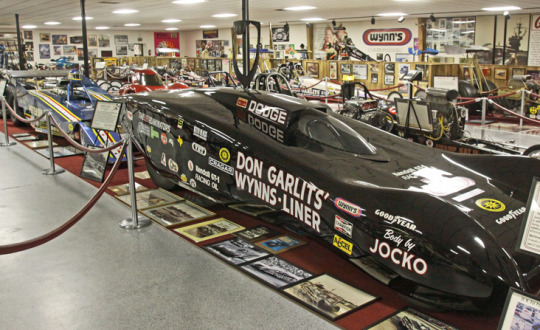
The story of Swamp Rat 17: Don Garlits' most misunderstood Top Fueler (part 2)
The Wynn’s Liner sits proudly in Garlits museum, parked just ahead of Petersen’s own failed attempt at aerodynamics, the Can Am-inspired Olympia Top Fuel car that lived its own all-too-short life in 1974.
Any chat with Don Garlits is always a thrill, but for history geeks like me, it’s especially thrilling because of his incredible memory. He turned 89 in January, but his memory is as clear as if he were 29. He, of course, knows his cars inside out, remembering specifically not only the number of each Swamp Rat but wheelbases, engines, and great stories associated with each. I do a lot of interviews with the stars of yesteryear and many, many of them, quite naturally as they age, have less than excellent recall. Then there's "Big Daddy." He's amazing.
So, as promised earlier in this column, I asked him to rank his Swamp Rats in order of favorites. Although I'm sure that, given time, he could have ranked them from 1 to 38, I asked only for his Top 5.
Here’s his Top 5, including portions of the descriptions I wrote for my trio of Swamp Rat Spotters Guides a few years ago (Swamp Rats I-A to X | Swamp Rats XI to 20-B | Swamp Rats 21 to 34):

No. 1, the first (1956-60): Although it wasn't his first dragster — he had made a crude, flathead-powered dragster from a '27-T roadster by moving the engine back and hanging a seat out over the rear end — it's the first car to wear the Swamp Rat name. The car was built on the framerails of a '31 Chevy passenger car that he bought at a junkyard for $35 in 1956; Garlits removed the frame from the body in the junkyard using little more than a large ax, a cold chisel, a ball-peen hammer, and a small assortment of hand tools. He transplanted most of the parts off of the flathead dragster to this car, except the driver seat, which was an old B-17 bomber seat. Initially using Ford power, Garlits switched to Chrysler Hemi power and later to high-gear-only. The carbureted version of this car is the one that beat the nay-saying Californians in Houston but got whipped by the West Coasters in Bakersfield, but as soon as "Big" added a blower, it was all over for everyone.
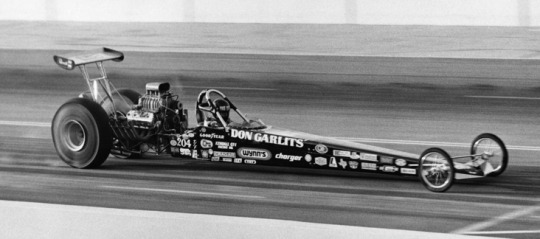
No. 22, the 5.63 car (1975): The car that succeeded SR 21 would go into the record books in a "big" way and stay there for years: This is the car in which Garlits brought the class to its knees with a 5.63-second clocking at the World Finals, a record that stood for more than six years. Built by Garlits, “T.C.” Lemons, and Don Cook on a 240-inch wheelbase, the car was lightweight and fast from the first go. He had hoarded oversized Goodyear slicks, built a new engine, and even lengthened the chassis by 10 inches, and it all paid off with that monstrous 5.63 that helped him win the event and the championship and was attached to the sport's first official 250-mph run. The historic car was retired at year's end and has never left Garlits' possession other than for occasional displays; it was hauled out of mothballs to run at — and win — the 1977 Gatornationals.
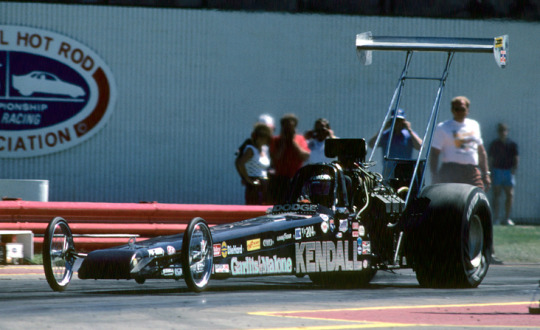
No. 26, the comeback car (1980-84): The follow-up to the porky “Godzilla” car, Swamp Rat 26 was "lean and light" — Garlits forsook paint for black anodized panels with stick-on lettering — and with the power that Garlits and Parks had learned to make to get the porky Godzilla car down the track, they seemed to be ahead of the game. The car was completed in time to run the Florida Winter Series events, but Parks quit that winter after the tough 1980 season, and Garlits won just two AHRA events in 1981. Garlits ran infrequently in the next three seasons, and Swamp Rat 26 might have just gone quietly into retirement as a disappointment had old pal Art Malone not called Garlits in the summer of 1984 and offered to fund a run at the 1984 Indy title. Malone got Garlits new parts, and they coaxed Parks out of retirement, and despite an aging car and a team of "dinosaurs" (Garlits' word), they won the race, completing a storybook comeback straight out of Hollywood. Garlits went on to also win a big eight-car Top Fuel show at Firebird Int'l Raceway and the NHRA World Finals — "Big Daddy" was back!
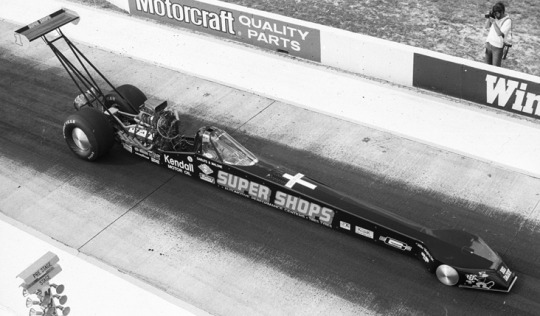
No. 30, the streamliner (1986): In the pantheon of famous Garlits cars, this cockpit-canopied streamliner may well be at the top of the pyramid. Garlits had Mike Magiera fabricate the nosepiece and constructed front "tires" out of 13-inch aluminum discs wrapped with industrial fan belts to fit beneath it. The belts would exit the wheels after almost every run, but that didn’t stop the “Rat Under Glass” from running 272.56 mph in the car's winning debut in Gainesville in 1986. Garlits later abandoned those wheels to run small-airplane tires that worked well but, ironically, took flight in his famous July 12 blowover wheelstand at the NHRA Summernationals. The car had to be backhalved in the Florida shop to complete the season, which ended with Garlits atop the points standings. Swamp Rat XXX also ran about half of the 1987 campaign and then famously became part of a display at the Smithsonian Institution the following year.
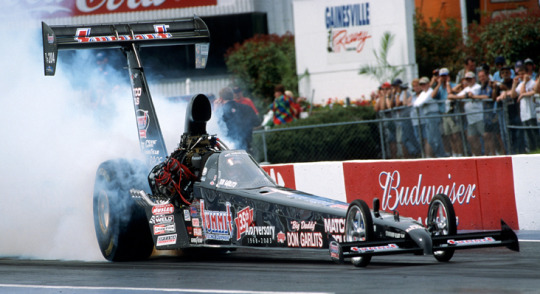
No. 34, the monowing car: Originally built in 1992 for Bruce Larson to drive after Garlits retired after experiencing eye problems caused by too many sudden parachute decelerations. At the end of the 1994 season, Garlits loaned the car to former Funny Car and fuel altered pilot Richard Langson and served as his crew chief in 1995, albeit with little success again. After years off the track, Garlits brought the car up to spec and competed at the 2002 Gatornationals and U.S. Nationals, then upped his speed mark to 323.04 at the 2003 Gatornationals. “It’s still the most modern Top Fueler in the world,” Garlits insisted to me. “It’s got the narrowed rear end and the mono wing rudder to make it go straight down the course, and the canopy.”
And, well, because Garlits was being so generous with his time and candor, I dared to ask him about his bottom five.

“Well, only a half-dozen cars that didn’t cut the mustard, but from what we’ve already talked about today," he said. "I think you know the five already: the streamliner (SR17), ‘Shorty' (SR18), the sidewinder (SR27), the turbine car (Swamp Rat 28-A), and then it would be Swamp Rat 12-A. That car [pictured above, was the first Swamp Rat to be designated with Arabic numerals instead of Roman numerals] was too short [just 137 inches], and we only ran that in the winter series in California."

My Spotters Guides from a few years ago ended at 34, but the numbers carried on after
35: 2009 DragPak stocker
36: 2011 Drag Pak stocker
37: First electric car
38: Second electric car
Swamp Rat 38 had been Garlits' hope for being the first battery-powered car to exceed 200 mph, but he was beaten to that mark last year by Steve Huff and parked the car.So, naturally, I had to ask Garlits if there would ever be a Swamp Rat 39.“Never say never,” he said, and I could detect a gleam in his eye even over a cellular connection. “Maybe I try to build a 250-mph electric car. There’s such fantastic battery technology coming, I don’t want to spend money on old technology. I still want to drive if I can by then. I still feel good, so I don't think that will be any problems.”Same ol' "Big Daddy." I can’t wait.Phil Burgess can reached at [email protected] of more articles like this can be found in the DRAGSTER INSIDER COLUMN ARCHIVE
18 notes
·
View notes
Photo

I took new pictures of all the Silver Ringnecks I currently have labelled and ready to go! From left to right, here are their prices and flaws: SR1 is 158 cm €150. Has an enlarged eye, slipped spot on belly. SR2 is 163 cm €150. Has small slips face and on belly. SR3 is 160 cm €155. Has small slips face, small hole above the nose. SR4 is 161 cm €145. Had some small slips on the face, bad tail. SR6 is 158 cm €160. Had a slightly enlarged eye, sewed inside (this is invisible from the fur side). SR7 is 168 cm €155. Has a small slip on face and belly, minor chew on tail tip. SR8 is 161 cm and €155. Has a slip below the front leg and a small slip on the face. SR10 is 162 cm and €155. Has some small holes in one ear, hole in the lower jaw (will sew this) and some thin hair below one front leg. SR16 is 174 cm and €155. Slips near the eye corners. SR17 is 161 cm and €160. Has a broken ear which will be sewed. As always, I can ship these anywhere in the world. These pelts do not have paws. I can do payment plans (for rules on payment plans, check the link in bio!). https://www.instagram.com/p/CUxCNKpqgJs/?utm_medium=tumblr
8 notes
·
View notes
Photo

DIFFUSEUR GAZ POUR TORCHE TIG SR17/26 Ø 2,4 MM Ref: PSTB45V44 PINCE PORTE ELECTRODE POUR TORCHE TIG SR171826 Ø 2,4 MM Ref PSTB13N23 #torche_mig_bernard #torche_tig_mig_binzel #parkertorches #starweld #starweld_maroc #gant_de_soudage #torche_de_soudage_tig_mig_plasma_parker #poste_à_souder_tig_mma_mig #awsoudage #soudage_soudeur_maroc #chalumeau_soudeur_coupeur #torche_plasma_hypertherm #Mano_detendeur_argon_yildiz_gaz #tablier_soudeur #materiel_de_soudure_maroc #Fourniture_soudure materiel de soudure maroc #Société_Marocaine_de_Matériel_soudure #weld #welding #welder #torche_de_soudage_tig_mig_plasma_starweld https://www.instagram.com/p/Cl5lIfGjuPw/?igshid=NGJjMDIxMWI=
#torche_mig_bernard#torche_tig_mig_binzel#parkertorches#starweld#starweld_maroc#gant_de_soudage#torche_de_soudage_tig_mig_plasma_parker#poste_à_souder_tig_mma_mig#awsoudage#soudage_soudeur_maroc#chalumeau_soudeur_coupeur#torche_plasma_hypertherm#mano_detendeur_argon_yildiz_gaz#tablier_soudeur#materiel_de_soudure_maroc#fourniture_soudure#société_marocaine_de_matériel_soudure#weld#welding#welder#torche_de_soudage_tig_mig_plasma_starweld
0 notes
Photo

My "mrs & mr" wanted to include their caravan, their akubras and their wine - tick, tick, tick! and they got a delicious cake too 🥂 I enjoyed making this wedding cake SO MUCH!! I can honestly say I have never studied a caravan's fixtures and fittings to this degree in my life! The amount of detail in this cake was huge! I'll share a video of the whole cake shortly... #caravanweddingcake #ediblecaravan #sugarmodels #mrsandmr #snowyrivercaravans #SR17 #handpainteddress #redwine #serafino #akubra #adelaidewedding #cakesadelaide #tastybakes #fleurieucake #willunga #aldinga #mclarenvale #wedding #winerywedding #tbwc #gosouthgolocal #southernvales #cakesofinstagram #carvedcake #caravancake (at Serafino Wines) https://www.instagram.com/p/CFgloC3jvry/?igshid=qeio1s9nmsl7
#caravanweddingcake#ediblecaravan#sugarmodels#mrsandmr#snowyrivercaravans#sr17#handpainteddress#redwine#serafino#akubra#adelaidewedding#cakesadelaide#tastybakes#fleurieucake#willunga#aldinga#mclarenvale#wedding#winerywedding#tbwc#gosouthgolocal#southernvales#cakesofinstagram#carvedcake#caravancake
0 notes
Text
Review: Furutech DSS-4.1 Speaker Cable & DPS-4.1 Power Cord

Furutech DSS-4.1 Speaker Cable & DPS-4.1 Power Cord
The Audiophile Weekend Warrior (TAWW)
TAWW Rating: 5 / 5
Attainable ultra-high-end performance.
PROS: Incredibly quiet, transparent and open-sounding; powerful and resolving frequency extremes; pure and organic midrange; fast and unfettered dynamics; remarkable sense of space.
CONS: Only sold in parts form, so you'll need to figure out termination; power cord can put some strain on jacks.
My first couple decades as an audiophile were relatively frugal. I bought a pair of used Merlin TSM speakers out of college that I used for 16 years. I rolled my own DIY speaker wire and bought $400 Sony and Onkyo CD players that I modified. My amplifier was a defective review sample that I repaired and got for pennies on the dollar. But after years of self-restraint, I started to slide down the slippery slopes of system upgrades. It started innocently enough with some used pieces... an Ayre integrated here, a Cambridge Audio streamer there... then came DAC upgrades, followed by nicer amplifiers, which naturally necessitated a better preamp. But things really took a turn for the crazy last year (I blame pandemic cabin fever) when speakers were upgraded to Audiovector SR 6 Avantgarde Arreté, which then led to the Gryphon Essence preamp and amp. Along the way I picked up the excellent Audience Au24 SX cables which, combined with Audience powerChord SEi's and a hodgepodge of other wire from Cardas, DH Labs and Mogami, have held me over. But with the system now scaling new heights of resolution and realism, the cable upgrade itch needed scratching... which leads us to the Furutech DSS-4.1 speaker cables ($395/m bulk; $3,138 as tested) and DPS-4.1 power cord ($480/m bulk; $1,458 as tested). While that might seem pricey for wire, they’re positioned to deliver the kind of ultra high-end performance associated with far more extravagant products. Could they deliver on that promise in the new TAWW reference rig?
DIY Ultra High-end??
Furutech is a Japanese cable and accessory manufacturer known for their fanatical attention to material and construction quality. Their AC power components are particularly acclaimed, and the distinctive NCF-series AC plugs and outlets can be found on the finished products of many other high-end marques. Similar to how manufacturers like Dynaudio used to sell raw drivers to other manufacturers while also building complete loudspeakers, Furutech seems perfectly content with anyone in the industry using their parts while they also sell finished products. The enterprising audiophile looking to construct or upgrade their own gear can find Furutech components readily available for purchase, though be warned - there are apparently a large number of knock-offs being peddled as genuine Furutech on eBay and other online marketplaces, so you'll want to stick to an authorized distributor. Fortunately for us in the States, we can turn to reputable online stores such as Music Direct, The Cable Company, Douglas Connection or any number of authorized dealers. The very friendly Scot Markwell of Elite A/V Distribution, Furutech's US distributor, provided the units under review here.
The DSS-4.1 speaker and DPS-4.1 and power cable represent the very highest-end Furutech wire you can buy in bulk - anything fancier requires factory termination. The two are effectively the same cable design, with the DPS version adding the requisite third conductor for grounding. I got a heads up to the remarkable properties of the power cord from my late friend Marty DeWulf a couple years back. Marty had been quietly consulting with an electrical engineer specializing in high-voltage power line transmission to construct his own power cords from scratch, and had reached a point where he felt his DIY concoctions outperformed the dozens of pricey high-end cords he had tried over the years. Marty sent me a number of development prototypes and I can attest that the cord was indeed superb and elevated the performance of most every amp I had at my disposal. Marty was feeling pretty happy with his effort until Scot @ Elite AV sent him some Furutech samples to try out, including the DPS-4.1. Sure enough, the DPS-4.1 performed at a different level from anything else Marty had tried before, including his own creations, and recalibrated his expectations for power cords - it was that good.
I later picked up the DPS-4.1 cable myself, along with the Furutech e-TP80 power distributor he praised, and confirmed their high level of performance. My appetite was whetted and I got in touch with Scot about kitting out the new reference rig with Furutech speaker and power wire throughout. This includes DPS-4.1 power cords on everything save the DAC, a GTO-D2R power distributor (review forthcoming) and DSS-4.1 speaker cables. All my samples were terminated with Furutech’s top-shelf rhodium-plated connectors - NCF plugs on the power cords, locking bananas and spades on the speaker cable. For the Gryphon Essence power amp, I had a 1.5m DPS-4.1 power cable made with 20A connectors. Since the Audiovector SR 6 speakers have tri-wire terminals, Scot also provided bare-wire jumpers made from the same PCOCC copper employed in the finished cables.

Using Furutech's PCOCC wire as tri-wire jumpers
Buying the Furutech parts and assembling the cables oneself can yield a considerable savings vs. finished cables, and most enterprising DIY'ers should be able to manage the job. However proper termination is critical to performance and safety, especially for the power cord, so if you're in any doubt, ask a dealer such as Douglas Connection to terminate them for you. Excluding any such labor, the retail cost of my 2.5m set of DSS-4.1 speaker cables with CF-202 bananas and FP-201 spades is $3,138. The 1.5m DPS-4.1 power cable with the FI-50/50M NCF plugs runs $1,458. High-end prices to be sure, but as you'll see below, I'd have no hesitation using these in systems that many would kit with far more costly wire.

The massive IEC connector is gorgeous and fits surely, but will put some stress on your jacks
Handling-wise, I'd call both on the lighter end of "garden hose," neither supple nor particularly stiff. At 19mm (0.75") thick for the speaker cable and 17mm (0.67") for the power cord, they're substantial but manageable. They'll bend easily enough into gentle curves, but the power cord will put strain on the chunky plugs if not given a good amount of clearance so don't expect to cram it into tight spaces. The speaker cable comes with an attractive woven sheath; the power cord has a purple PVC jacket, but my cables were clad in a silver Techflex sleeve for a more finished look. Both have 11AWG conductors which should allow for plenty of current flow in a typical run, and the speaker cable's capacitance is rated at 51.7pF/m (15.6pF/ft) @ 1kHz. This is an exceptionally low figure - for comparison, Kimber Kable 8TC is rated at 346pF/m, while Cardas Clear is a whopping 912pF/m - nearly 18x the Furutech! The tradeoff is a higher inductance of 0.7µH/m, but at typical lengths the effect of this should be benign.
Furutech DSS-4.1 Speaker Cable

Before we begin: since it’s impossible to say what any one component sounds like in isolation, I made most of my comparisons of the Furutech DSS-4.1 to my current reference cable, the excellent Audience Au24 SX ($3,300/2m pair). I also had Cardas Clear Light, DH Labs Q-10 Signature and a few other things on hand, but given that the Audience is the best of what I had available and is closest in price to the Furutech, most of my comments are relative to the Audience.
The best way I can describe the sound of the Furutech cable is "wide open." Compared to other cables I've had at my disposal, swapping in the Furutech sounds equivalent to the visual effect of renovating your living room from normal-sized windows to floor-to-ceiling glass. Suddenly everything feels more open, airy and illuminated. Notice that I didn't say "brighter - there’s a difference. The Furutech allows more sonic light to pass into your listening room, so when the music is brilliant and luminous, your room is suitably illuminated. But once the sun sets, that wall of glass becomes as pitch black as the night sky - and so the Furutech can be quiet and dark when called for.
In less fanciful terms, the Furutech gives the feeling of extremely wide bandwidth with no attenuation of energy or dynamics across the frequency spectrum, particularly at the extreme highs and lows. This helps it unlock more of the capability of my recent system upgrades - the top-to-bottom dynamics of the Audiovector speakers and ultra-wide-bandwidth of the Gryphon separates. In the lower frequencies the Furutech is a big step up in bass energy and resolution, transmitting more of a recording's energy and tone in the bottom three octaves. Note that this is different from having “big” or “warm” bass - similar to my illumination vs. brightness comment above, those denote colorations that constantly tilt the perceived spectral balance in a certain direction. There is no lower frequency hump or resonance here that could sound favorable on first listen but get a little monotonous in the long run. The Furutech simply allows what’s present in the signal to be transmitted more unimpeded than I have heard before in my system. This gives music tremendous “surprise” factor - it can go from ethereal to thunderous in a heartbeat. And this applies not just when used on the big Audiovectors; it's also a quality I heard on a scaled-back system with the Silverline SR17 Supreme 2-way monitors.
The top end has a similar level of transparency and dynamism, revealing all sorts of harmonics and textures as well as the air and ambience of the venue with striking transparency. Triangle, cymbals, trumpet, violin, and harpsichord are a few examples of instruments with complex high-frequency structure that sound exceptionally realistic via the DSS-4.1. At first, I felt the treble of the Furutech was a bit coarser vs. the Audience, which I have always found to be notably smooth and natural. I initially ascribed this to break-in, and gave the wire a couple hundred hours with a 4 ohm dummy load to try to burn it off. It improved, but it still had a bit of lingering grain. With time, two things became apparent: this cable takes a REALLY long time to break in - things kept getting smoother and smoother over the next couple hundred hours - and the Furutech simply refuses to cover anything up. Once I made the substantial upgrade to the Gryphon Essence combo I realized that grain was mostly endemic to my previous components, which were no slouches themselves - we’re talking all Class A discrete electronics from Pass Labs and Valvet. That just shows you the level of resolution the Furutech brings into play.
Once integrated into a system of even higher caliber, the Furutech sounded close to invisible, with great openness, clarity and detail from top to bottom and little discernible artifact. That said, at some points I did adjust the top end a bit by moving the Furutech's connection to the Audiovector speakers from the tweeter terminal to the midrange terminal. When connected to the tweeter terminal as per Audiovector recommendation (and my standard practice with other cables), things could get a hair bright, and some of the aforementioned coarseness would pop up now and again. Again, the Furutech was just telling it like it was, because later after further improvements to the system (a dedicated 20A power line, IsoAcoustics Gaia feet, breaking in the latest firmware on the PS Audio DAC), the top end sweetened and I was able to return the cables to the tweeter terminal for best transparency. In my system's current state, the Furutech brings out a top end that's wonderfully sweet, extended and natural.

A few other standout aspects bear mentioning. One is the sheer size of the soundstage, both in width and depth. I'm not sure exactly how components that have no effect on actual channel separation can affect the perceived width of the stage so much. Maybe it's a phase thing, maybe it's low level resolution that helps with ambient retrieval, maybe it's dynamic capability to bring out instruments that tend to be at the edges of the stage... whatever it is, the Furutech is able to convey a stage of substantial depth, width and dynamism. Another standout is the Furutech’s ability to convey dynamic contrasts. This is a quiet and fast cable that responds adroitly to the most minute changes in dynamic character, conveying both the undulations of a quiet melody and the surge of an orchestral climax with great color and intensity. Finally, the midrange is wonderfully dense, pure and harmonically complete, with great solidity in the lower range. Unlike many audiophile cables that provide lots of detail and speed at the expense of fullness or balance, the Furutech can better most comers in the "hifi" aspects while bringing out all the natural warmth of a great acoustic recording. Baritones, grand pianos, french horns and celli have never sounded better.
By comparison, the Audience Au24 SX is still a wonderful if more midrange-centric cable. Its slightly laid-back perspective and silkier treble are appealing for a variety of systems, particularly those on the forward side of neutral. There's a roundness and sweetness to the midrange, but at the expense of sounding a hair more congealed, bunching instruments together on a narrower stage. It also isn’t quite as responsive to quick and subtle dynamic contrasts, and the top end isn't as realistic and extended. Prior to hearing the Furutech the Audience was actually one of the best cables I had heard in many of these regards, so we're already talking about a very high level of performance here. And compared to something like the Cardas Clear Light, the Furutech was far more resolving while having a warmer, purer midrange and a sweeter treble.
The DSS-4.1 is an exceptionally transparent, balanced and complete speaker cable that can bring greater levels of realism and naturalness to a commensurate system. It delivers the type of detail and energy one would expect from an ultra high-end wire, but in an honest and unforced manner that draws one to the qualities of the source material and music without distraction. The net musical result is music has wider variation in color, texture, nuance and ultimately emotional impact - or as another reviewer put it, "expressiveness is their strong point."
Furutech DPS-4.1 Power Cord

Remarkably (or perhaps not?), virtually all the qualities that the DSS-4.1 exhibits as a speaker cable also shine through with the DPS-4.1 as a power cord. My longstanding reference is also an Audience cable - the moderately priced powerChord SE-i ($930/6 ft). It’s an incredibly consistent performer that imparts greater body, dynamics and life to most any component vs. a stock cord, not to mention a good number of aftermarket ones.
Compared to the Audience powerChord, again, the Furutech felt wide-open, more transparent and better balanced. The powerChord was a bit meatier in the mid bass and slightly sweeter on the top end - certainly more forgiving, but a little filtered compared to the Furutech. The Furutech also had a much wider and better-spaced soundstage; I won't say "twice as wide and 3x as deep" or anything with such false precision, but it certainly felt significantly bigger, with a lot more air between instruments and a stage that consistently spread beyond the width of the speakers. On pop mixes, this exhibited as stereo reverb and hard-panned effects that popped much more distinctly. Compared to the Audience and anything else I had on hand, the Furutech allowed whatever was plugged into it to transmit more recorded nuance with a sense of effortless transparency, particularly at the frequency extremes.
But like any cable regardless of quality, the Furutech wasn't the best match for everything I had on hand. I found the Audience cable more competitive with the PS Audio DAC; the Valvet A4 Mk.II monoblocks have a bit of upper midrange shine that was slightly prominent with the Furutech; and with the Class D Legacy i·v2 amplifier it was actually the very affordable Audience Forte that clicked better than the rest. But otherwise, the Furutech really shone with the majority of preamps and amps I tried, especially anything Pass Labs.
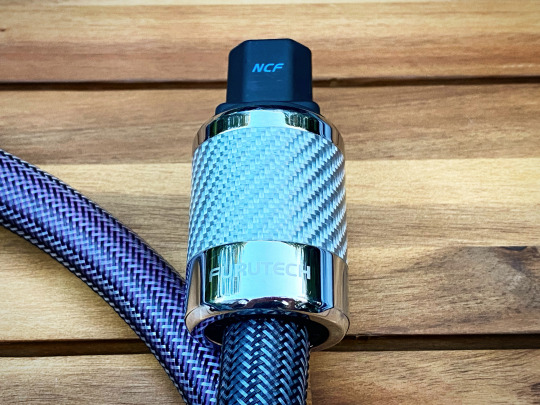
With the Gryphon Essence preamp, switching from the Furutech back to the Audience wasn’t a huge let-down by any means. And at first blush, the Audience sounded a bit more dense and focused than the Furutech, particularly in the lower midrange. But a few notes into Billie Eilish's "iomilo" [Qobuz] I realized what I was hearing as density was actually a bit of congestion, and the soundstage was quite a bit narrower than with the Furutech... everything sounded a bit more congealed around the center image of Eilish's voice. With the Furutech, the Gryphon preamp was able to eerily float effects around the entire space of the front of my living room, with percussion flourishes sprinkled throughout the track twinkling in ethereal fashion. With the Audience, everything lost some luster and became more confined between the speakers, and the frequency extremes lost some speed and impact. The DPS-4.1 cable really unleashed the wide-bandwidth capabilities of my system, maximizing both the epic bass depth, power and control of the Gryphon electronics as well as the purity and extension of the Audiovector's AMT tweeters. None of this is meant to beat up on the Audience, which costs about half as much as the Furutech and remains one of my favorite cords, but rather to elucidate how a cord like the Furutech can further elevate the performance of a system. At some point, I'll have to get around to trying Audience's latest models, such as the Studio ONE powerChord (closer in price) or the FrontRow (though that one costs 3x as much as the Furutech).
Testing the DPS-4.1 with the Gryphon Essence stereo amplifier was a bit trickier due to the need for a 20 amp IEC connector, so I special-ordered one for this purpose. Once set up, the Furutech rewarded me with incredible detail, an ultra-wide and deep soundstage that extended far beyond my walls, deep and impactful bass response and a heightened sense of purity - the "blackness" between the notes. Transients were immaculate, with perfectly clean attacks and decays - not excessively sharp, not softened, but just natural and energetic. This helped create the sense of greater macro and micro dynamic range; lots of subtle shadings and nuances in the music became clearer, while sudden transients were more explosive. There was a greater sense of both calm and energy with everything, where quiet moments felt finer and more delicate, while pops of energy in the performance burst forward with an effortless impact more akin to the live event. Separation, pitch, and articulation of bass notes were made more exceptional as well. It brought out the more rarefied capabilities of ultra high-end gear like the Gryphon - that ability to hear every element of a performance distinctively, yet perfectly integrated into the overall fabric of the music. All these qualities came to the fore listening to complex, dynamic material such as Strauss Don Juan [Qobuz]. I was struck by just how much clearer a window the Furutech gave into the dense, at times cacophonous orchestration, while making tranquil moments such as the idyllic oboe solo even more delicate and nuanced. The overall performance of the Gryphon + Furutech pairing was exceptional.

One combo where the Furutech power cord worked even better than the speaker cable was with the Pass Labs XA30.5 amplifier. With the DSS-4.1 speaker cable, there was a bit of a tradeoff where the enhanced resolution revealed some of the shortcomings of the amp vs. the more refined (and expensive) Gryphon Essence. However the DPS-4.1 power cord was dynamite with the Pass, helping maximize its dynamics and balance out its midrange warmth with bottom-end impact and top-end extension. The Pass Labs XP10 line stage also never sounded better than with the Furutech cord, with improved dynamics, soundstaging and clarity. The lack of noise and grain further strengthened the quietness, purity and sweetness that many find so endearing of Class A gear. The outstanding synergy with the Pass Labs components makes the Furutech DPS-4.1 cord about as no-brainer a recommendation as I can make for any Pass owner.
Conclusion
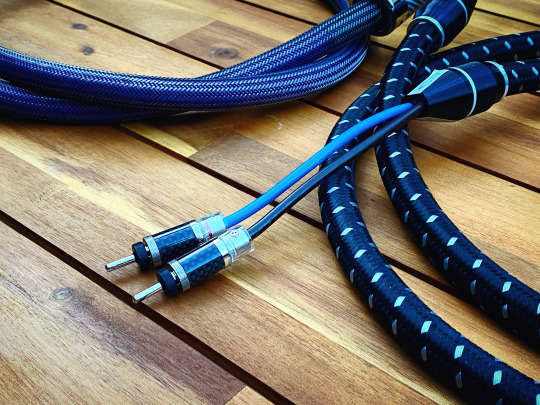
The Furutechs were remarkably consistent in their sonic impact. Both the speaker and power cables impart a wide-open feeling, with striking resolution at the frequency extremes, powerful low-end response, highly agile dynamics, super low noise floor and no readily-discernible coloration. They are extremely fast and clean without curtailing any sweetness or richness intrinsic to the music. Both cables are a tad more forward than my Audience reference wire, the Au24 SX speaker cable and powerChord SE-i power cord. There’s a hair more upper midrange energy and treble resolution that will require care with some systems, though it’s less prominent than, say, something with silver or silver-plated conductors such as DH Labs Q-10 or Nordost Valhalla. And the power cord in particular took the extension and resolving power of my system to a different level. They both strike me as reference-caliber cables, exacting enough to round out a tweaked-out $100k system, yet balanced enough to elevate something more modest, with plenty of headroom to grow into more ambitious gear. In particular, if you have a system with significant extension at the frequency extremes, they’ll help extract the most out of those capabilities. And as well as they work with my reference Gryphon separates, I absolutely love how they elevate Pass Labs gear, enhancing their intrinsic warmth and musicality with greater clarity, dynamics and precision. They'll be staying in the system for the long haul as a TAWW reference cable. Very highly recommended!
3 notes
·
View notes
Text
New theory: Grimes didn't accidentally tweet SR17. It was a call for help that she's only 17 and a slave to the lizard person driving Elon Musk's meat-piece-suit.
#Prove It Ain't#Bet#Musk#Elon Musk#Rosemary's Baby#Damon#The Unholy Spawn Marks The Beginning Of The End
6 notes
·
View notes